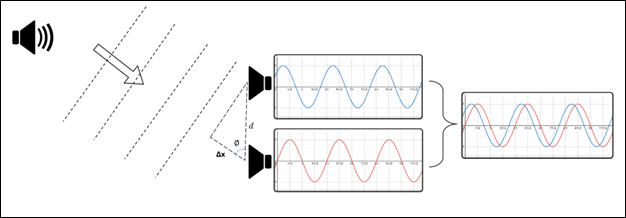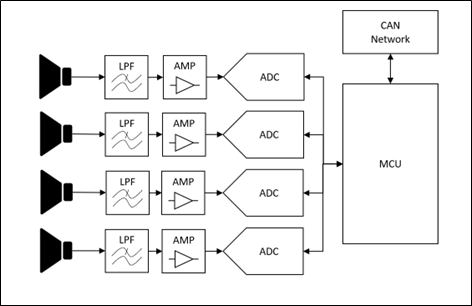The following theory of operation is taken from my engineering analysis (separate document). It might sound a bit awkwardly formal for these logs, but it explains the concept of this design pretty well… and I don’t want to rewrite the theory of operation : ) .
*From engineering analysis*
To understand the theory of operation, consider a small hydrophone array consisting of two hydrophones separated by a known distance (d), shown in Figure 1. These hydrophones receive acoustic pressure waves from an un-identified “target” and convert them to weak electrical signals via a piezoelectric transducer [1]. Depending on the position of the target, the signals received by the hydrophones will be identical, although phase shifted, copies of one another. If the acoustic propagation constant is known, then this phase shift can be directly related to the angle of arrival of the incoming plane wave.

There are several assumptions that need to be considered when implementing this model. Foremost, this model assumes the propagation speed is known and constant; however, this parameter depends on the water temperature, water depth, and water salinity [3]. Next, consider the 2D model in Figure 1, if the illustration is extrapolated to a 3D space, the solution would have a cone of solutions at angle. Even this 2D model leads to an extraneous root symmetric about the two hydrophones. Lastly, the angle of arrival assumption requires a plane wave. For this assumption to be appropriate, the distance from the target to the hydrophone must be much greater than the distance (d) between the hydrophones.
Implementing the solution on hardware is feasible based on existing systems used on various AUV’s such as [2]. There are many methods to implement this system on hardware, so only a generalized overview will be provided. The block diagram is shown in Figure 2, and consists of an analog front end for filtering and amplification of the incoming signal, an analog to digital converter (ADC) to discretize the waveform, and a microprocess to interpret the results.

 Jesse Farrell
Jesse Farrell
Discussions
Become a Hackaday.io Member
Create an account to leave a comment. Already have an account? Log In.